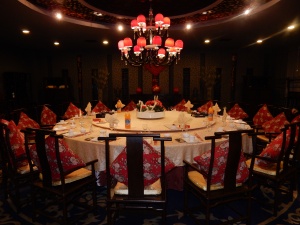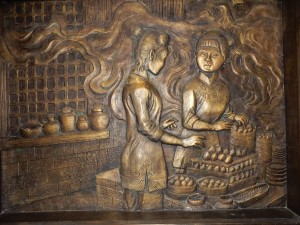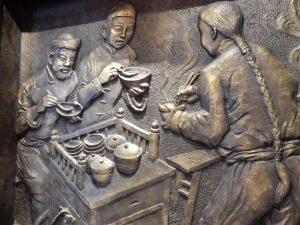When I’m at home in Canada, Sunday is grocery shopping day. As my husband and I trudge up one aisle and down the next, filling our cart with food that looks the same as last week’s and last week’s before that, I’m occasionally overcome by a feeling of irritated boredom. “Why can’t someone invent some new kind of food?” I ask no one in particular, although my husband feels since he’s standing next to me, it’s his job to answer.
“Well, what do you want?”
“I don’t know,” I grumble. “Something different.”
If you have ever felt a similar ennui with your day to day diet, I have a piece of advice for you:
During the four weeks I spent there, I lost track of the different menu items I tried. I rarely ate the same dish twice. If I did, it was because my first taste inspired me to return for a second – and a third.
Now, if I’m being perfectly honest, my relationship with eating in China didn’t start out that smoothly. When my teaching partner and I went to the hotel dining room, or to the restaurants in the immediate neighbourhood, we discovered the menus were written in Chinese only. Between our non-existent Mandarin and the servers’ lack of English, we rarely knew what or how to order. Sometimes, the menus contained pictures that we could point at, but even then, we often ended up with dishes that bore little resemblance to what we thought we’d be eating.
After admitting these restaurant challenges to our grad student guides and the professors we were teaching, we began to eat like royalty. With their assistance, we sampled student hangouts near campus, hotel buffets, shopping mall restaurants, hotpot holes-in-the-wall, and even a few Western restaurants. Our Chinese colleagues navigated their way adeptly through the menus, switching swiftly between English and Mandarin as they asked about our preferences (seafood, yum; organ meat, not so much; spicy, a little), then discussed the dishes with the server.
Sometimes, this back and forthing went on for a very long time. When I asked one of the grad students about this, he said, “In China, the dishes appear on the menu by name only. There are many regional variations of each dish, so we have to ask about what ingredients are used in this particular version. Not only that, you never know whether the dish is enough for one or a family of five. And even then, when the dish finally arrives, sometimes we get a surprise!”



 More often than not, though, the surprises were pleasant. If I didn’t recognize the dish’s ingredients, the students would consult the translation app on their phones and show me the results: Lotus root. Spicy snake. Black tortoise jelly. Bullfrog. Taro. Black rice purple potato bags. Stinky tofu. Green onion pancake. Needle mushrooms.
More often than not, though, the surprises were pleasant. If I didn’t recognize the dish’s ingredients, the students would consult the translation app on their phones and show me the results: Lotus root. Spicy snake. Black tortoise jelly. Bullfrog. Taro. Black rice purple potato bags. Stinky tofu. Green onion pancake. Needle mushrooms.
Often, our food selections were made even tastier by the environment in which we ate them. Some restaurants took great pride in how they presented their dishes. One hotel buffet presented each food type as part of an artistic display. More casual restaurants provided small creative fluorishes, designed to make the food as pleasing to the eye as to the palate.
One of my favorite eating styles was the hot pot, which allowed us to cooked our own food at the table. The students took us to several different types of hot pot restaurants. One featured a large cooking vessel, full of boiling water, in the centre of each table. We chose the meat, seafood, vegetables, noodles, and dipping sauces from a large buffet, brought them back to the table, and dunked them in the water, regularly replenished by our server. At another hot pot location, we each had our own pot, which featured different flavors of broth. Although we cooked in the pot nearest to where we were seated, we sampled regularly from all the others.

 Once, in a shopping mall hot pot restaurant, our server prepared some of the dishes for us at the table. When it was time to put the noodles into the dish, the students said, “Get your camera ready, Pam!” The server smiled, and removed a short, fat noodle from a plate. She stepped back from the table, one end of the noodle in each hand, and, arms wide, whipped it in front of her like a child’s skipping rope. The noodle stretched to at least ten times its original length! The server performed this trick several more times until she had enough noodles for the dish, then left us to enjoy her workmanship.
Once, in a shopping mall hot pot restaurant, our server prepared some of the dishes for us at the table. When it was time to put the noodles into the dish, the students said, “Get your camera ready, Pam!” The server smiled, and removed a short, fat noodle from a plate. She stepped back from the table, one end of the noodle in each hand, and, arms wide, whipped it in front of her like a child’s skipping rope. The noodle stretched to at least ten times its original length! The server performed this trick several more times until she had enough noodles for the dish, then left us to enjoy her workmanship.
 But my favorite feature of eating in China was the sense of connection that dining out inspired. People like to eat in groups around large tables, the better to accommodate not only more people but more food. The larger tables were often equipped with a lazy susan, where the server placed the heaped up platters. People spun the lazy susan and took a tiny portion of food with their chopsticks, rather than a large scoop. Sometimes, the person sitting next to me would place a morsel on my plate, which one of my students explained was a gesture of friendship. In between bites, there was lots of lip-smacking, wine- and tea-sipping, talking, and laughing.
But my favorite feature of eating in China was the sense of connection that dining out inspired. People like to eat in groups around large tables, the better to accommodate not only more people but more food. The larger tables were often equipped with a lazy susan, where the server placed the heaped up platters. People spun the lazy susan and took a tiny portion of food with their chopsticks, rather than a large scoop. Sometimes, the person sitting next to me would place a morsel on my plate, which one of my students explained was a gesture of friendship. In between bites, there was lots of lip-smacking, wine- and tea-sipping, talking, and laughing.
 It’s been almost two months since I returned home from China to the predictable foods and eating habits of North American dining. But, recently, I found out that one of the Changsha professors will be visiting my home city with a contingent of colleagues. Yes! An excuse to visit Chinatown, and re-experience the Chinese eating experience. But that’s three weeks away. Of course, all good hosts need to ensure quality control on their guests’ menus. I wouldn’t want them to go home disappointed….
It’s been almost two months since I returned home from China to the predictable foods and eating habits of North American dining. But, recently, I found out that one of the Changsha professors will be visiting my home city with a contingent of colleagues. Yes! An excuse to visit Chinatown, and re-experience the Chinese eating experience. But that’s three weeks away. Of course, all good hosts need to ensure quality control on their guests’ menus. I wouldn’t want them to go home disappointed….
This post is fondly dedicated to the memory of my uncle, Ed Wigmore. Although he was terminally ill while I was in China, he continued to follow my blog enthusiastically. He said the posts were very interesting to read, but that I hadn’t addressed one of the most important questions he had: How was the food?





What a wonderfully written article for your uncle. I’m sure you carried him away from the symptoms of his illness through your much anticipated posts.
LikeLike
Thanks, Debbie. My uncle’s last e-mail to me, in which he commented on the China posts, and asked, “But how’s the food?” will always have a special place in my heart.
LikeLike
Uncle Ed would have so enjoyed this post! Somewhere he is smiling down on you.
Deb
LikeLike
So now I really want some good chinese food! Such appetizing reading.
LikeLike
Oh, you clever punster. After I finished writing, I tried to track down places for Szechuan food in Edmonton. I’ve got a couple of places I’d like to try – all in the name of job research, of course.
LikeLike
Haha – of course – “Research”! Let me know if you find any winners!
LikeLike